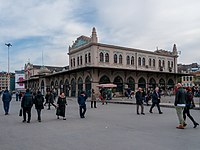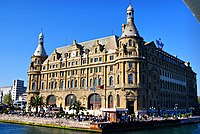SEA VIEW KADIKOY APARTMENTS
- City: Kadikoy Apartments
- Property type: Apartment
- Bedrooms: 1
- Offer type: For Sale
- Neighborhood: Kadıköy
- Bathrooms: 1
- Property size: 66 m²
- Property ID: 15807
Features
- Administrative support
- ATM
- Cafe
- Car Park
- Central heating
- Dishwasher
- Garden
- Gym
- Investment properties
- Lift
- Luxury Property
- Reception services
- Restaurant
- Sauna
- Security System
- Swimming Pool
Details
ULTRA LUXURY APARTMENT FOR SALE WITH SEA VIEW
Site Features
Outdoor swimming pool
Children’s swimming pool
Children’s playgrounds
Shopping Mall
Security
Camera security
Sea view
Islands view
Parking Garage
Walking track
Sun terrace
Building Features
Water tank
Booster
Generator
Elevator
Housing Features
Central heating
Heat share meter
Construction Techniques
Building inspection
Ground survey done
Compliant with earthquake regulations
In compliance with the insulation regulation
SEA VIEW KADIKOY APARTMENTS
Kadıköy
Jump to navigationJump to search
|
Kadıköy
Kadıköy Belediyesi
|
|
|---|---|
| Municipality of Kadıköy | |

Images from Kadıköy, Top: Haydarpaşa Terminal, Middle left: Atatürk monument, Middle right: Nostalgic tramway, Bottom: Bağdat Avenue.
|
|
 |
|
| Coordinates: 40°59′28″N 29°01′34″ECoordinates: 40°59′28″N 29°01′34″E | |
| Country | Turkey |
| Province | Istanbul Province |
| Government | |
| • Mayor | Şerdil Dara Odabaşı (CHP) |
| Area | |
| • District | 40.21 km2 (15.53 sq mi) |
| Population
(2018)[2]
|
|
| • District | 458,638 |
| • District density | 11,000/km2 (30,000/sq mi) |
| Website | www |
Haydarpaşa Terminal of the Turkish State Railways, near Kadıköy centrum
Kadıköy (Turkish pronunciation: [ˈkadɯcœj] (![]() listen)), known in classical antiquity and during the Roman and Byzantine eras as Chalcedon (Greek: Χαλκηδών), is a large, populous, and cosmopolitan district in the Asian side of Istanbul, Turkey, on the northern shore of the Sea of Marmara. It partially faces the historic city centre of Fatih on the European side of the Bosporus. Kadıköy is also the name of the most prominent neighbourhood of the district, a residential and commercial area that, with its numerous bars, cinemas and bookshops, is the liberal cultural centre of the Anatolian side of Istanbul. Kadıköy became a district in 1928 when it was separated from Üsküdar district. The neighbourhoods of İçerenköy, Bostancı and Suadiye were also separated from the district of Kartal in the same year,[citation needed] and eventually joined the newly formed district of Kadıköy. Its neighbouring districts are Üsküdar to the northwest, Ataşehir to the northeast, Maltepe to the southeast, and Kartal beyond Maltepe.
listen)), known in classical antiquity and during the Roman and Byzantine eras as Chalcedon (Greek: Χαλκηδών), is a large, populous, and cosmopolitan district in the Asian side of Istanbul, Turkey, on the northern shore of the Sea of Marmara. It partially faces the historic city centre of Fatih on the European side of the Bosporus. Kadıköy is also the name of the most prominent neighbourhood of the district, a residential and commercial area that, with its numerous bars, cinemas and bookshops, is the liberal cultural centre of the Anatolian side of Istanbul. Kadıköy became a district in 1928 when it was separated from Üsküdar district. The neighbourhoods of İçerenköy, Bostancı and Suadiye were also separated from the district of Kartal in the same year,[citation needed] and eventually joined the newly formed district of Kadıköy. Its neighbouring districts are Üsküdar to the northwest, Ataşehir to the northeast, Maltepe to the southeast, and Kartal beyond Maltepe.
History
Kadıköy is an older settlement than most of those on the Anatolian side of the city of İstanbul. Relics dating to 5500-3500 BC (Chalcolithic period) have been found at the Fikirtepe Mound, and articles of stone, bone, ceramic, jewelry and bronze show that there has been a continuous settlement since prehistoric times. A port settlement dating from the Phoenicians has also been discovered. Chalcedon was the first settlement that the Greeks from Megara established on the Bosphorus, in 685 BC, a few years before they established Byzantium on the other side of the strait in 667 BC. Chalcedon became known as the ‘city of the blind’, the story being that Byzantium was founded following a prophecy that a great capital would be built ‘opposite the city of the blind’ (meaning that the people of Chalcedon must have been blind not to see the obvious value of the peninsula on the Golden Horn as a natural defensive harbour). The fourth ecumenical church council, Council of Chalcedon, was held there in 451 AD.
Chalcedon changed hands time and time again, as Persians, Bithynians, Romans, Byzantines, Arabs, Crusaders, and Turks passed through the area, which was badly damaged during the Fourth Crusade and came into Ottoman hands in 1353, a full century before Constantinople. Thus, Kadıköy has the oldest mosque in İstanbul, built almost a century before the conquest of Constantinople in 1453.[citation needed]
At the time of the conquest, Chalcedon was a rural settlement outside the protection of the city. It was soon put under the jurisdiction of the Constantinople courts, hence the name Kadıköy, which means Village of the Judge. In the Ottoman period, Kadıköy became a market for agricultural goods and in time developed into a residential area for people who would commute to the city by boat.
According to Ottoman estimations of 1882, the district of Kadıköy had a total population of 6,733, consisting of 2,695 Muslims, 1,831 Armenians, 1,822 Greeks, 249 Jews, 92 Latins, 28 Bulgarians and 16 Catholics.[3]
Kadıköy today
Transport
The major Haydarpaşa Terminal of the Turkish State Railways is located close to Kadıköy’s centre and was opened in 1908 as the terminus of the İstanbul-Baghdad and İstanbul-Damascus-Medina railways. The terminal closed due to infrastructure works in 2013[4] and reopened in 2018, serving east- and south-bound international, domestic and regional trains.
The Söğütlüçeşme railway station, the next station after Haydarpaşa Terminal, is the terminus of the Metrobus line to European side of İstanbul.
The M4 line of the Istanbul Metro runs from Kadıköy to Tavşantepe daily between 6:00 and 23:57.[5]
The centre of Kadıköy today is the transportation hub for people commuting between the Asian side of the city and the European side across the Bosphorus. There is a large bus and minibus terminal next to the ferry quay. Ferries are the most dominantly visible form of transport in Kadıköy, and the central market area is adjacent to the ferry quay.
Public transportation with terminus in Kadıköy:
- 4 Kadıköy-Bostancı ring (via Bağdat Avenue)
- 8A West Ataşehir
- 10B Bostancı
- 16 Pendik (via Bağdat Avenue)
- 17 Pendik (via so-called minibus way)
- 19F Yeditepe University
- 19M Ataşehir via Ataşehir Boulevard.
- 130A Tuzla
- 222 Pendik (via Bağdat Avenue)
- E-10 Sabiha Gökçen Airport
- ER1 Ring Erenköy (passes through Bağdat Avenue)
- ER2 Ring Erenköy (passes through Bağdat Avenue)
- FB1 Ring Fenerbahçe (passes through west point of Bağdat Avenue)
- FB2 Ring Fenerbahçe (passes through west point of Bağdat Avenue)
- GZ1 Ring Göztepe (passes through Bağdat Avenue)
- GZ2 Ring Göztepe (passes through Bağdat Avenue)
To European side,
- 110 Taksim
- 112 Taksim
- 500A Edirnekapı
For more lines, visit: http://www.iett.istanbul/en/main/hatlar
- M4 Kadıköy-Tavşantepe (extension to Sabiha Gökçen International Airport under construction)
- T3 (Ring) Mühürdar-Bahariye-Moda (in centrum)
Traditional ferries,[6]
Sea buses,[7]
- ID: 15807
- Published: April 25, 2021
- Last Update: August 21, 2022
- Views: 608













